英语语法专题精讲精练-动名词
- 格式:doc
- 大小:143.00 KB
- 文档页数:7
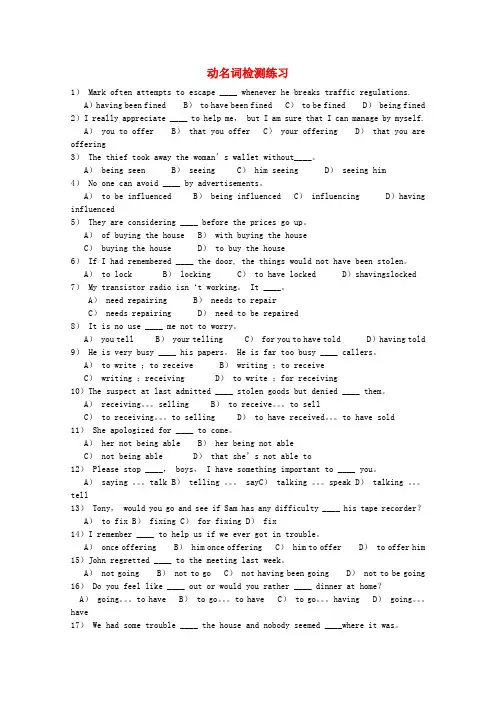
动名词检测练习1) Mark often attempts to escape ____ whenever he breaks traffic regulations.A)having been fined B) to have been fined C) to be fined D) being fined 2)I really appreciate ____ to help me, but I am sure that I can manage by myself.A) you to offer B) that you offer C) your offering D) that you are offering3)The thief took away the woman’s wallet without____。
A) being seen B) seeing C) him seeing D) seeing him4) No one can avoid ____ by advertisements。
A) to be influenced B) being influenced C) influencing D)having influenced5) They are considering ____ before the prices go up。
A) of buying the house B) with buying the houseC) buying the house D) to buy the house6) If I had remembered ____ the door, the things would not have been stolen。
A) to lock B) locking C) to have locked D)shavingslocked 7)My transistor radio isn‘t working。
![[精]中考英语语法丨动名词-详解与练习](https://uimg.taocdn.com/3af1099fb52acfc789ebc9d3.webp)
中考英语语法丨动名词I.要点动名词既具有动词的一些特征,又具有名词的句法功能。
1、动名词的形式,以write为例。
否定式not +动名词2、动名词的用法(1)作主语Playing football is my favorite sport.Travelling with friends at weekend is fun. 作主语的动名词结构复杂且长时,可用it作形式主语。
如:It is fun travelling with friends at weekend.(2)作宾语I enjoy playing PC game.He gave up writing five years ago.(3)作表语What he hated most was doing nothing.Seeing is believing. 动名词作表语时,句子的主语常是无生命名词或what引导的名词性从句。
(4)作定语There's a dining room in my school.All the people watching laughed.(5)动名词的复合结构"物主代词(或名词的所有格)+动名词"。
如:Tom's going home late made her mother angry.Would you mind myopening the window? 不过,动名词的逻辑主语在遇到以下情况时,必须用名词的普通格(或人称代词的宾格)。
①无生命名词The girls were afraid of the door suddenly closing.Fire burns better byoxygen being at work.②有生命名词,但表泛指。
Have you ever heard of girls smoking?③两个以上的有生命的名词并列。
Do you still remember my parents and me coming to see you that day? 3.后面常接动名词的动词和短语mind介意, enjoy喜欢, finish完成, consider认为, practise实践, magine 想象, keep保持, suggest建议, advise建议, allow允许, permit, be worth doing值得做…, be used to doing习惯于…, be busy doing忙于…,can't help doing禁不住……, it is no good doing, it is no use doing,look forward to doing盼望…, stick to doing坚持…, pay attention to doing 注意…,devote to doing, lead to doingII.例题例1She says she doesn't feel like ____ out with you.A goingB to goC for goingD went解析:该题正确答案为A。
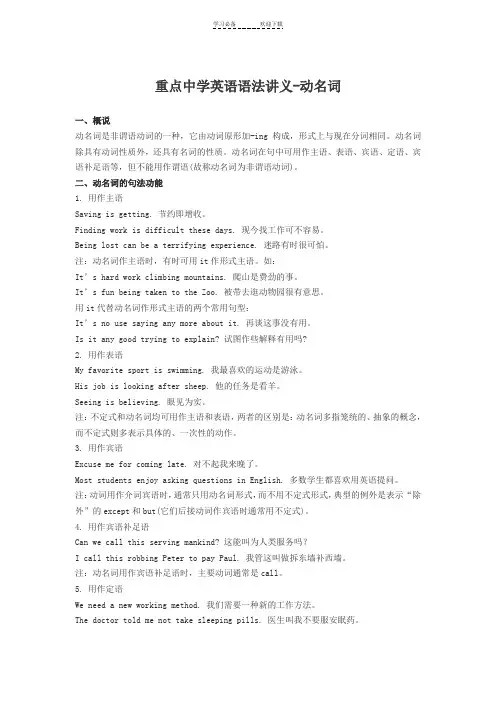
重点中学英语语法讲义-动名词一、概说动名词是非谓语动词的一种,它由动词原形加-ing构成,形式上与现在分词相同。
动名词除具有动词性质外,还具有名词的性质。
动名词在句中可用作主语、表语、宾语、定语、宾语补足语等,但不能用作谓语(故称动名词为非谓语动词)。
二、动名词的句法功能1. 用作主语Saving is getting. 节约即增收。
Finding work is difficult these days. 现今找工作可不容易。
Being lost can be a terrifying experience. 迷路有时很可怕。
注:动名词作主语时,有时可用it作形式主语。
如:It’s hard work climbing mountains. 爬山是费劲的事。
It’s fun being taken to the Zoo. 被带去逛动物园很有意思。
用it代替动名词作形式主语的两个常用句型:It’s no use saying any more about it. 再谈这事没有用。
Is it any good trying to explain? 试图作些解释有用吗?2. 用作表语My favorite sport is swimming. 我最喜欢的运动是游泳。
His job is looking after sheep. 他的任务是看羊。
Seeing is believing. 眼见为实。
注:不定式和动名词均可用作主语和表语,两者的区别是:动名词多指笼统的、抽象的概念,而不定式则多表示具体的、一次性的动作。
3. 用作宾语Excuse me for coming late. 对不起我来晚了。
Most students enjoy asking questions in English. 多数学生都喜欢用英语提问。
注:动词用作介词宾语时,通常只用动名词形式,而不用不定式形式,典型的例外是表示“除外”的except和but(它们后接动词作宾语时通常用不定式)。
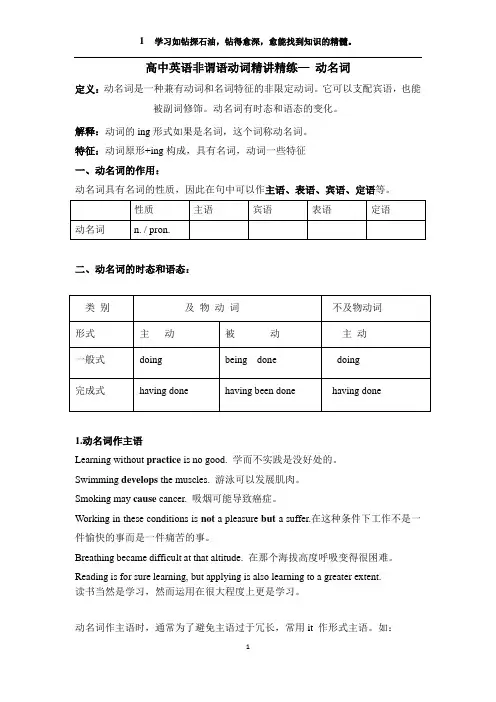
高中英语非谓语动词精讲精练—动名词定义:动名词是一种兼有动词和名词特征的非限定动词。
它可以支配宾语,也能被副词修饰。
动名词有时态和语态的变化。
解释:动词的ing形式如果是名词,这个词称动名词。
特征:动词原形+ing构成,具有名词,动词一些特征一、动名词的作用:动名词具有名词的性质,因此在句中可以作主语、表语、宾语、定语等。
二、动名词的时态和语态:1.动名词作主语Learning without practice is no good. 学而不实践是没好处的。
Swimming develops the muscles. 游泳可以发展肌肉。
Smoking may cause cancer. 吸烟可能导致癌症。
Working in these conditions is not a pleasure but a suffer.在这种条件下工作不是一件愉快的事而是一件痛苦的事。
Breathing became difficult at that altitude. 在那个海拔高度呼吸变得很困难。
Reading is for sure learning, but applying is also learning to a greater extent.读书当然是学习,然而运用在很大程度上更是学习。
动名词作主语时,通常为了避免主语过于冗长,常用it 作形式主语。
如:①It’s +no good(no use, fun, a pleasure, a waste of time)+doing…It’s no good reading in dim light.It’s no use sitting here waiting.It’s no use arguing with him. 跟他争论没用。
②It’s+形容词+doingIt’s dangerous swimming in the sea in windy days.It is dangerous using this method to measure the speed of light.用这种方法去测量光速是危险的。
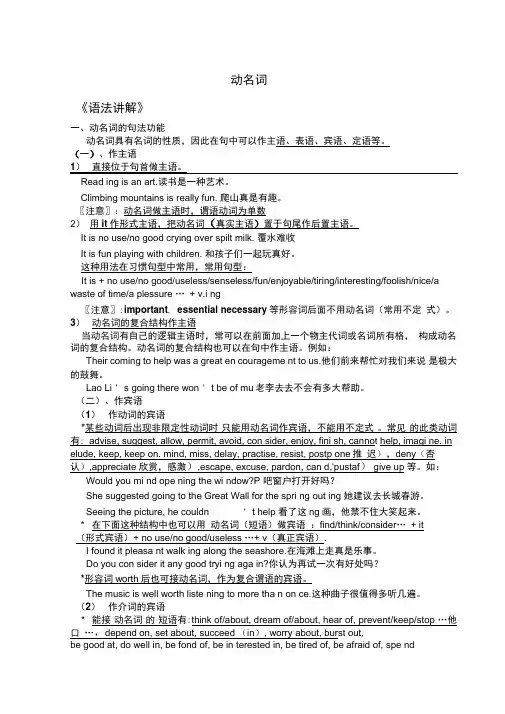
动名词《语法讲解》一、动名词的句法功能动名词具有名词的性质,因此在句中可以作主语、表语、宾语、定语等。
(一)、作主语1)直接位于句首做主语。
Read ing is an art.读书是一种艺术。
Climbing mountains is really fun. 爬山真是有趣。
〖注意〗:动名词做主语时,谓语动词为单数2)用it作形式主语,把动名词(真实主语)置于句尾作后置主语。
It is no use/no good crying over spilt milk. 覆水难收It is fun playing with children. 和孩子们一起玩真好。
这种用法在习惯句型中常用,常用句型:It is + no use/no good/useless/senseless/fun/enjoyable/tiring/interesting/foolish/nice/a waste of time/a plessure … + v.i ng〖注意〗:important, essential necessary等形容词后面不用动名词(常用不定式)。
3)动名词的复合结构作主语当动名词有自己的逻辑主语时,常可以在前面加上一个物主代词或名词所有格,构成动名词的复合结构。
动名词的复合结构也可以在句中作主语。
例如:Their coming to help was a great en courageme nt to us.他们前来帮忙对我们来说是极大的鼓舞。
Lao Li ' s going there won ' t be of mu老李去去不会有多大帮助。
(二)、作宾语(1)作动词的宾语*某些动词后出现非限定性动词时只能用动名词作宾语,不能用不定式。
常见的此类动词有: advise, suggest, allow, permit, avoid, con sider, enjoy, fini sh, cannot help, imagi ne. in elude, keep, keep on. mind, miss, delay, practise, resist, postp one推迟),deny(否认),appreciate 欣赏,感激),escape, excuse, pardon, can d,'pustaf) give up 等。

专题10 重点语法复习(动名词作主语和宾语)养成良好的答题习惯,是决定高考英语成败的决定性因素之一。
做题前,要认真阅读题目要求、题干和选项,并对答案内容作出合理预测;答题时,切忌跟着感觉走,最好按照题目序号来做,不会的或存在疑问的,要做好标记,要善于发现,找到题目的题眼所在,规范答题,书写工整;答题完毕时,要认真检查,查漏补缺,纠正错误。
总之,在最后的复习阶段,学生们不要加大练习量。
在这个时候,学生要尽快找到适合自己的答题方式,最重要的是以平常心去面对考试。
英语最后的复习要树立信心,考试的时候遇到难题要想“别人也难”,遇到容易的则要想“细心审题”。
越到最后,考生越要回归基础,单词最好再梳理一遍,这样有利于提高阅读理解的效率。
另附高考复习方法和考前30天冲刺复习方法。
动名词1. 基础知识动名词是非谓语动词的一种形式。
它既有动词的特征,又有名词的特征,故称动名词。
动名词也有时态和语态的变化,如表所示(以及物动词write为例),不及物动词没有语态的变化。
动词ing形式作主语通常表示抽象的或习惯性的动作。
也可用t作形式主语,动词-ing形式作真正的主语放在句末。
下列句型中常用动词-ing形式作主语:1. It is/was a waste (of...)/no use/no good doing sth.2. There is/was no sense/no point...(in) doing sth.It is no good coming before that.在那之前来没有用。
There is no sense(in)worrying about it now.现在大可不必为那件事忧虑。
特别注意:名师点津区分动词不定式及动词-ing形式作主语(1)动词-ing形式多表示一般的、抽象的、泛指的概念或一个已经完成了的动作,而不定式则表示具体的某一次行为或将来的动作,不过有时二者之间区别很小。
To look after these naughty boys is really difficult.照看这些淘气的男孩真是难。
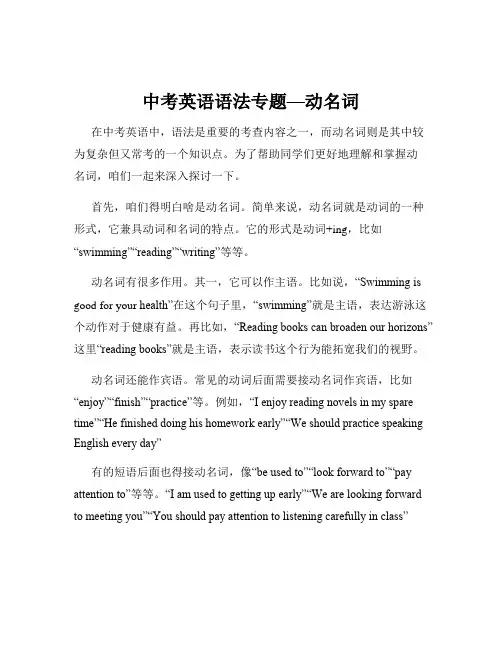
中考英语语法专题—动名词在中考英语中,语法是重要的考查内容之一,而动名词则是其中较为复杂但又常考的一个知识点。
为了帮助同学们更好地理解和掌握动名词,咱们一起来深入探讨一下。
首先,咱们得明白啥是动名词。
简单来说,动名词就是动词的一种形式,它兼具动词和名词的特点。
它的形式是动词+ing,比如“swimming”“reading”“writing”等等。
动名词有很多作用。
其一,它可以作主语。
比如说,“Swimming is good for your health”在这个句子里,“swimming”就是主语,表达游泳这个动作对于健康有益。
再比如,“Reading books can broaden our horizons”这里“reading books”就是主语,表示读书这个行为能拓宽我们的视野。
动名词还能作宾语。
常见的动词后面需要接动名词作宾语,比如“enjoy”“finish”“practice”等。
例如,“I enjoy reading novels in my spare time”“He finished doing his homework early”“We should practice speaking English every day”有的短语后面也得接动名词,像“be used to”“look forward to”“pay attention to”等等。
“I am used to getting up early”“We are looking forward to meeting you”“You should pay attention to listening carefully in class”动名词还能作定语。
比如“a swimming pool”“a reading room”,这里的“swimming”和“reading”就是定语,分别修饰“pool”和“room”,表示用途。
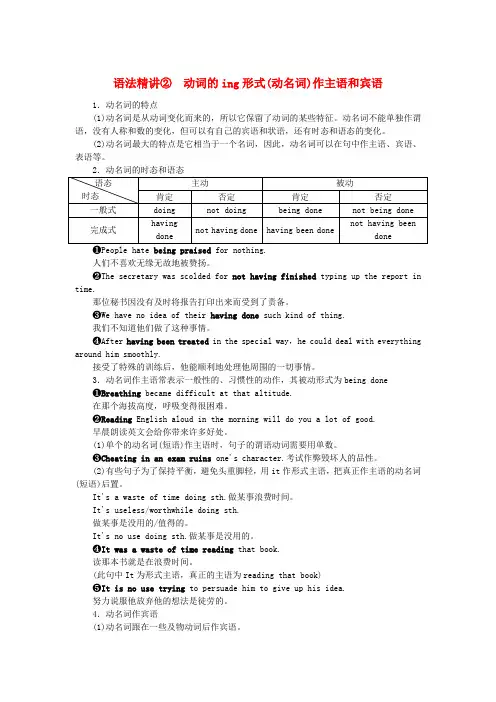
语法精讲②动词的ing形式(动名词)作主语和宾语1.动名词的特点(1)动名词是从动词变化而来的,所以它保留了动词的某些特征。
动名词不能单独作谓语,没有人称和数的变化,但可以有自己的宾语和状语,还有时态和语态的变化。
(2)动名词最大的特点是它相当于一个名词,因此,动名词可以在句中作主语、宾语、表语等。
❶People hate being praised for nothing.人们不喜欢无缘无故地被赞扬。
❷The secretary was scolded for not having finished typing up the report in time.那位秘书因没有及时将报告打印出来而受到了责备。
❸We have no idea of their having done such kind of thing.我们不知道他们做了这种事情。
❹After having been treated in the special way,he could deal with everything around him smoothly.接受了特殊的训练后,他能顺利地处理他周围的一切事情。
3.动名词作主语常表示一般性的、习惯性的动作,其被动形式为being done❶Breathing became difficult at that altitude.在那个海拔高度,呼吸变得很困难。
❷Reading English aloud in the morning will do you a lot of good.早晨朗读英文会给你带来许多好处。
(1)单个的动名词(短语)作主语时,句子的谓语动词需要用单数。
❸Cheating in an exam ruins one's character.考试作弊毁坏人的品性。
(2)有些句子为了保持平衡,避免头重脚轻,用it作形式主语,把真正作主语的动名词(短语)后置。
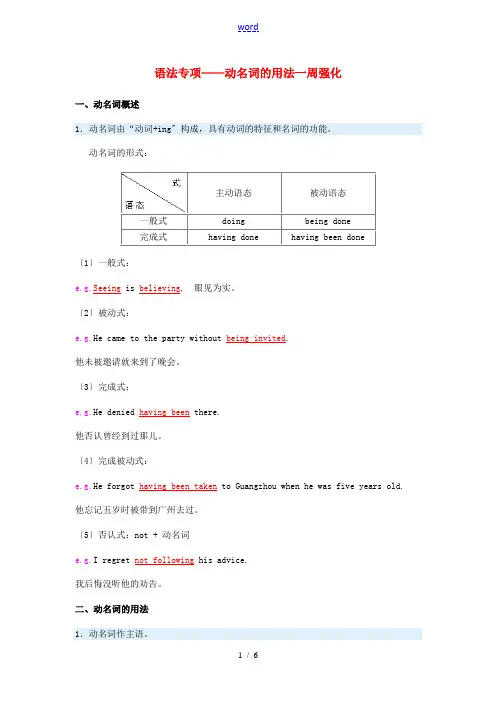
语法专项——动名词的用法一周强化一、动名词概述1.动名词由“动词+ing〞构成,具有动词的特征和名词的功能。
动名词的形式:主动语态被动语态一般式doing being done完成式having done having been done〔1〕一般式:e.g.Seeing is believing. 眼见为实。
〔2〕被动式:e.g.He came to the party without being invited.他未被邀请就来到了晚会。
〔3〕完成式:e.g.He denied having been there.他否认曾经到过那儿。
〔4〕完成被动式:e.g.He forgot having been taken to Guangzhou when he was five years old. 他忘记五岁时被带到广州去过。
〔5〕否认式:not + 动名词e.g.I regret not following his advice.我后悔没听他的劝告。
二、动名词的用法1.动名词作主语。
ying eggs is the ant queen’s full-time job.产卵是蚁后的专职工作。
Saying is easier than doing.说比做容易。
在下面两种结构中,动名词也作主语。
〔1〕为了保持句子平衡,通常用it作形式主语,而把真实主语动名词〔短语〕放在句末。
e.g plaining to her is useless.对她抱怨毫无用处。
可转化为:It is useless complaining to her.It is no use crying over spilt milk.作无益的后悔是没有用的。
It’s a waste of time arguing about it.辩论这事是浪费时间。
〔2〕在There is no结构中,通常动名词。
e.g.There is no joking about such matters.这种事开不得玩笑。
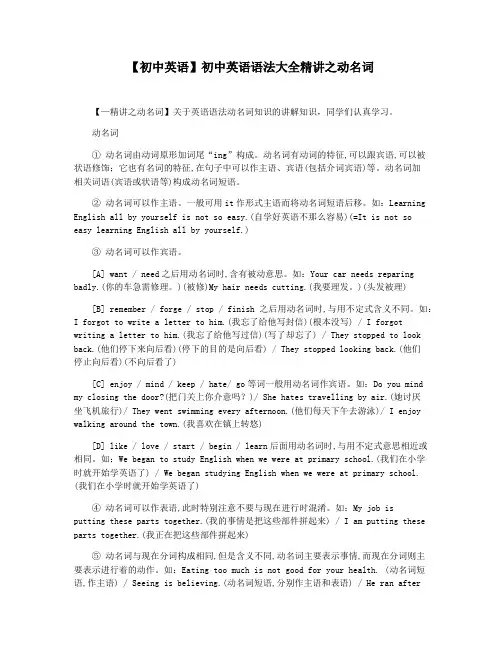
【初中英语】初中英语语法大全精讲之动名词【—精讲之动名词】关于英语语法动名词知识的讲解知识,同学们认真学习。
动名词① 动名词由动词原形加词尾“ing”构成。
动名词有动词的特征,可以跟宾语,可以被状语修饰;它也有名词的特征,在句子中可以作主语、宾语(包括介词宾语)等。
动名词加相关词语(宾语或状语等)构成动名词短语。
② 动名词可以作主语。
一般可用it作形式主语而将动名词短语后移。
如:Learning English all by yourself is not so easy.(自学好英语不那么容易)(=It is not so easy learning English all by yourself.)③ 动名词可以作宾语。
[A] want / need之后用动名词时,含有被动意思。
如:Your car needs reparing badly.(你的车急需修理。
)(被修)My hair needs cutting.(我要理发。
)(头发被理)[B] remember / forge / stop / finish之后用动名词时,与用不定式含义不同。
如:I forgot to write a letter to him.(我忘了给他写封信)(根本没写) / I forgot writing a letter to him.(我忘了给他写过信)(写了却忘了) / They stopped to look back.(他们停下来向后看)(停下的目的是向后看) / They stopped looking back.(他们停止向后看)(不向后看了)[C] enjoy / mind / keep / hate/ go等词一般用动名词作宾语。
如:Do you mind my closing the door?(把门关上你介意吗?)/ She hates travelling by air.(她讨厌坐飞机旅行)/ They went swimming every afternoon.(他们每天下午去游泳)/ I enjoy walking around the town.(我喜欢在镇上转悠)[D] like / love / start / begin / learn后面用动名词时,与用不定式意思相近或相同。
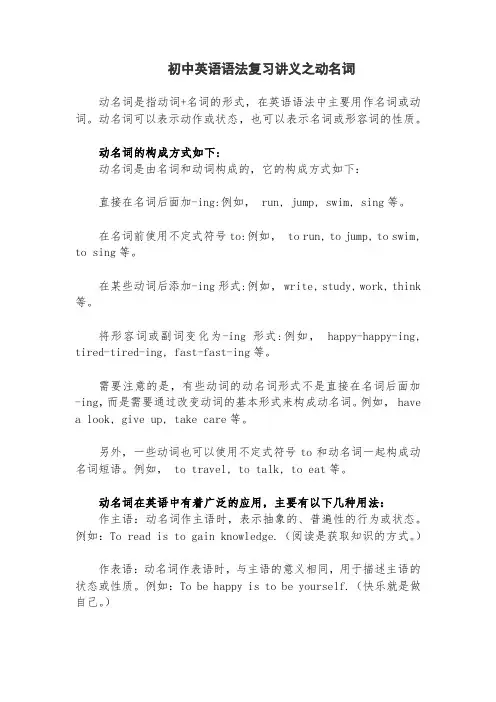
初中英语语法复习讲义之动名词动名词是指动词+名词的形式,在英语语法中主要用作名词或动词。
动名词可以表示动作或状态,也可以表示名词或形容词的性质。
动名词的构成方式如下:动名词是由名词和动词构成的,它的构成方式如下:直接在名词后面加-ing:例如, run, jump, swim, sing等。
在名词前使用不定式符号to:例如, to run, to jump, to swim, to sing等。
在某些动词后添加-ing形式:例如, write, study, work, think 等。
将形容词或副词变化为-ing形式:例如, happy-happy-ing, tired-tired-ing, fast-fast-ing等。
需要注意的是,有些动词的动名词形式不是直接在名词后面加-ing,而是需要通过改变动词的基本形式来构成动名词。
例如, have a look, give up, take care等。
另外,一些动词也可以使用不定式符号to和动名词一起构成动名词短语。
例如, to travel, to talk, to eat等。
动名词在英语中有着广泛的应用,主要有以下几种用法:作主语:动名词作主语时,表示抽象的、普遍性的行为或状态。
例如:To read is to gain knowledge.(阅读是获取知识的方式。
)作表语:动名词作表语时,与主语的意义相同,用于描述主语的状态或性质。
例如:To be happy is to be yourself.(快乐就是做自己。
)作宾语:动名词作宾语时,通常用于表达动作或行为的结果。
例如:To learn a new language requires time and effort.(学习一门新语言需要时间和努力。
)作定语:动名词作定语时,通常用于修饰名词,表示动作或行为的性质或特点。
例如:The art of painting requires practice and patience.(绘画需要练习和耐心。
中考英语语法专题—动名词在中考英语中,语法是非常重要的一部分,而动名词则是语法中的一个关键知识点。
今天,咱们就来好好聊聊中考英语中的动名词。
首先,咱们得搞清楚啥是动名词。
简单来说,动名词就是动词的ing 形式,它既有动词的特征,又有名词的性质。
比如说,“swimming”(游泳)、“reading”(阅读),这就是动名词。
那动名词都有啥作用呢?它主要有这么几个用途。
其一,动名词可以作主语。
举个例子,“Swimming is my favorite sport”(游泳是我最喜欢的运动。
)在这个句子里,“swimming”就是主语,它表示一种动作或活动。
其二,动名词可以作宾语。
像“ I enjoy reading books ”(我喜欢读书。
)这里的“reading books”就是宾语,表明喜欢的具体内容。
其三,动名词还能作表语。
比如说,“Her job is teaching English”(她的工作是教英语。
)“teaching English”在这儿就是表语,用来说明主语的身份或职业。
接下来,咱们再说说动名词的一些常见搭配和固定用法。
比如“be used to doing sth”(习惯于做某事),“look forward to doing sth”(期待做某事),“prefer doing sth to doing sth”(比起做某事更喜欢做某事)等等。
这些固定搭配在中考中可是经常出现的,大家一定要牢记。
再说说动名词和现在分词的区别。
这也是容易让同学们混淆的地方。
动名词强调的是一种动作的名称或者用途,而现在分词强调的是动作正在进行。
比如说,“The sleeping baby is so cute”(这个正在睡觉的宝宝太可爱了。
)这里的“sleeping”是现在分词,强调“正在睡”这个动作;而“Sleeping is necessary for our health”(睡觉对我们的健康是必要的。
高中英语语法之动名词定义:动名词是一种兼有动词和名词特征的非限定动词。
它可以支配宾语,也能被副词修饰。
动名词有时态和语态的变化。
解释:动词的ing形式如果是名词,这个词称动名词。
特征:动词原形+ing构成,具有名词,动词一些特征一、动名词的作用动名词具有名词的性质,因此在句中可以作主语、表语、宾语、定语等。
1、作主语Reading is an art.读书是一种艺术。
Climbing mountains is really fun.爬山真是有趣Working in these conditions is not a pleasure but a suffer.在这种工作条件下工作不是一件愉快的事而是一件痛苦的事。
动名词作主语,有时先用it作形式主语,把动名词置于句末。
这种用法在习惯句型中常用。
如:It is no use/no good crying over spilt milk.覆水难收It is a waste of time persuading such a person to join us.劝说这样的人加入真是浪费时间。
It was hard getting on the crowded street car.上这种拥挤的车真难。
It is fun playing with children.和孩子们一起玩真好。
There is no joking about such matters.对这种事情不是开玩笑。
动名词作主语的几种类型动名词可以在句子中充当名词所能充当的多种句子成分。
在这里仅就动名词在句子中作主语的情况进行讨论。
动名词作主语有如下几种常见情况:1.直接位于句首做主语。
例如:Swimming is a good sport in summer.2.用it作形式主语,把动名词(真实主语置于句尾作后置主语。
动名词做主语时,不太常用it作先行主语,多见于某些形容词及名词之后。
例如:It is no use telling him not to worry.常见的能用于这种结构的形容词还有:better,wonderful,enjoyable,interesting,foolish,difficult,useless,senseless,worthwhile,等。
英语语法:动名词的详细分析讲解 1. 动名词概说 动名词既具有动词的性质,⼜具有名词的性质,因此叫动名词。
①动名词的动词性质表现在,它可以和宾语或状语组成动名词短语 如: My job is arranging the agenda for my boss. 我的⼯作是为⽼板安排⽇程。
I finished the project in a month by working overtime. 我靠加班在⼀个⽉内做完了这个项⽬。
②动名词的名词性质表现在,它可以在句⼱⽤作主语、宾语等 如: Studying abroad can be a good experience. 留学是⼀种很好的经历。
(作主语) I regret telling her the truth. 我后悔告诉她事实真相了。
(作宾语) 2. 动名词的形式和特征 动名词由“动词原形do+ - ing”构成。
动名词有以下时态与语态的变化: ①动名词的⼀般式 1)⼀般式所表⽰的动作和谓语动词的动作同时发⽣,表⽰经常性、习惯性的动作(或状态),也可能在谓语动词表⽰的动作之后发⽣。
I enjoy skiing in nature. 我享受在⼤⾃然中滑雪。
(enjoy与skiing同时发⽣) He insisted on going with us. 他坚持跟我们⼀起去。
(going发⽣在insisted on之后) 2)有的动名词所表⽰的动作发⽣在谓语动词表⽰的动作之前,如: We don't remember reading the article before. 我们不记得以前看过这篇⽂章了。
(reading发⽣在remember之前) They will never forget running into the super model in the mall. 他们永远不会忘记在商场⾥偶遇那位超模。
(running into发⽣在forget之前) ②动名词的完成式 动名词的完成式表⽰的动作发⽣在谓语动词表⽰的动作之前。
动名词精讲精练核心知识:1. 含义:动词名词化2._________________(write) the book has taken up all his spare time._________________(receive) a new bike as her birthday present made little Tim so happy.________________(misunderstand) by others is always annoying.________________( operate) on made the patient free from danger of dying.固定句型:It’s no use ___________(cry) over spilt milk.It’s no good __________(talk) a lot without doing anything.2. 动名词(短语)用作宾语①下列动词后只能接动名词:consider; finish; practise; avoid; risk; suggest/advise/recommend; enjoy/appreciate; mind; allow/permit; admit; give up; delay; postpone; escape; excuse/pardon, miss; keep/insist on; imagine/fancy; can’t help/stand,考虑完成多练习, 避免冒险求建议。
面对喜欢和介意,允许承认或放弃。
推迟逃避不原谅,错过坚持要想象.He was in low spirits and even consider _____(go ) away.Practise __________( put ) your hand to the ground.I can’t help _________( persuade ) to buy that sweater.Don’t tell me you always escape _____( fine) because you have a fast sports car.He didn’t feel like ______( work ), so he suggested _____( spend ) the day in the garden.You certainly mustn’t miss _______( see ) the wonderful film.The man is lucky enough to escape ______________(punish)We appreciate ____________( help ) in our difficulties.Michael has delayed ______( write ) to her till today.The law forbids ______( sell )liquor to children.They all suggested ______( give ) more chances.Can you imagine ______( leave ) standing outside for a whole night.They built the banks to prevent the area from ______( flood).②下列动词短语接动名词:leave off, put off, give up, look forward to, feel like, have trouble / difficulty (in) doing sth. devote to, get used to, be accustomed to; pay attention to, be fond of, be worth。
高中英语语法动名词一. 概念动名词由动词原形+ING构成,是一种非谓语动词形式二. 相关知识点精讲:1.作主语。
例如:Fighting broke out between the South and the North. 南方与北方开战了。
2.作宾语a. 有些动词可以用动名词作宾语。
例如:admit 承认appreciate 感激avoid 避免complete完成consider认为delay 耽误deny 否认detest 讨厌endure 忍受enjoy 喜欢escape 逃脱fancy 想象finish 完成imagine 想象mind 介意miss 想念postpone推迟practice 训练recall 回忆resent 讨厌resume 继续resist 抵抗risk 冒险suggest 建议face 面对include 包括stand 忍受understand 理解forgive 宽恕keep 继续例如:Would you mind turning down your radio a little, please? 你把收音机音量调小一点,好吗The squirrel was lucky that it just missed being caught. 这松鼠幸运得很,刚逃避了被逮住的厄运。
b. 有些结构后面可以用动名词作宾语或其他成分。
例如:admit to prefer,to be used to lead to devoteoneself toobject to stick to no good no use be fond of look forwardtobe proud ofstick to no good no use be fond of look forwardtobe proud of be busy can't help be tired of be capableofbe afraid of think ofburst out keep on insist on count on set aboutput off be good at take up give up be successfulin3.作表语,对主语说明、解释。
中考英语语法专题―动名词 5中考英语语法专题―动名词 5 5、动名词作状语动名词作状语表示在进行一动作的同时所进行的另一动作,它对谓语动词起修饰和陪衬的作用。
动名词作状语可以表示时间、原因、条件、让步、结果、方式或伴随情况。
Having cleaned the rooms we began to weed the garden. (时间)打扫完房间,我们开始在花园里除草。
Coming into the room, she saw everybody already at their work. (时间)进屋以后,她看到人人都在工作。
Being ill, he couldn't go to school. (原因)因为生病,他不能去上学。
Having no interest in the topic, he didn't go to the lecture. (原因)由于对这个话题没有兴趣,他没去参加讲座。
Working diligently, you will certainly succeed. (条件)只要刻苦学习,你会成功的。
Using atomic energy, we can build spaceships. (条件)利用原子能,我们能够建造太空船。
Granting the achievements to be great, there is still something to be desired. (让步)(尽管)成绩是巨大的,(但)仍有一些要求改进的东西。
My car was caught in a traffic jam, thus causing the delay. (结果)我的车被交通拥挤堵住,所以延误了。
Traveling by train, we visited a number of cities. (方式) 我们坐火车访问了好多城市。
Mary sat by the window of the classroom, reading a book. (伴随)玛丽坐在教室的窗户旁,正在读一本书。
动名词定义:动名词是动词的一种非限定形式,兼有动词和名词的特征,它可以带宾语,也能被状语修饰。
动名词接宾语或状语构成动名词短语。
动名词有时态和语态的变化。
基本形式:由动词原形家词尾-ing构成,与现在分词形式相同。
动名词已经名词化了,而现在分词常表示动作或状态。
如:a sleeping chair 躺/睡椅(动名词,表用途) a sleeping child 正在睡觉的孩子(现在分词,表状态)一、动名词的句法功能动名词具有名词的性质,因此在句中可以作主语、表语、宾语、定语等。
1、作主语1)直接位于句首做主语。
Reading is an art. 读书是一种艺术。
Climbing mountains is really fun. 爬山真是有趣。
Working in these conditions is not a pleasure but a suffering. 在这种工作条件下工作不是一件愉快的事而是一件痛苦的事。
注意:动名词做主语时,谓语动词为单数2)用it 作形式主语,把动名词(真实主语)置于句尾作后置主语。
It is no use/no good crying over spilt milk. 覆水难收It is a waste of time persuading such a person to join us. 劝说这样的人加入真是浪费时间。
It was hard getting on the crowded street car. 上这种拥挤的车真难。
It is fun playing with children. 和孩子们一起玩真好。
这种用法在习惯句型中常用,常用句型:It is + no use/no good/useless/senseless/fun/enjoyable/tiring/interesting/foolish/nice/a waste of time/a plessure… + v.ing注意:important,essential,necessary 等形容词后面不用动名词(常用不定式)。
3)用于“There be”结构中。
There is no saying when he'll come.很难说他何时回来。
There is no joking about such matters. 对这种事情不是开玩笑。
There is no holding back the wheel of history. 历史的车轮不可阻挡。
常用句型:There is no + v.ing = It is impossible to do …注意:在“There be”句型中,只能用动名词,而不能用不定式作主语。
4)用于布告形式的省略结构中。
No smoking ( =No smoking is allowed (here) ). 禁止吸烟。
No parking. 禁止停车。
5)动名词的复合结构作主语当动名词有自己的逻辑主语时,常可以在前面加上一个物主代词或名词所有格,构成动名词的复合结构。
动名词的复合结构也可以在句中作主语。
例如:Their coming to help was a great encouragement to us. 他们前来帮忙对我们来说是极大的鼓舞。
Lao Li’s going there won’t be of much help. 老李去不会有多大帮助。
2、作宾语(1)作动词的宾语*某些动词后出现非限定性动词时只能用动名词作宾语,不能用不定式。
常见的此类动词有:advise, suggest, allow, permit, avoid, consider, enjoy, finish, cannot help, imagine, include, keep,keep on, mind, miss, delay, practise, resist, postpone(推迟),deny(否认), appreciate (欣赏,感激), escape, excuse, pardon, can’t stand, put off, give up等。
如:Would you mind opening the window?吧窗户打开好吗?She suggested going to the Great Wall for the spring outing. 她建议去长城春游。
Seeing the picture, he couldn’t help laughing. 看了这幅画,他禁不住大笑起来。
Mark often attempts to escape being fined whenever he breaks traffic regulations.每当马克违反交通规则时,他常常企图逃避罚款的处分。
*在下面这种结构中也可以用动名词(短语)做宾语:find/think/consider… + it(形式宾语)+ no use/no good/useless… + v.ing(真正宾语).I found it pleasant walking along the seashore. 在海滩上走真是乐事。
Do you consider it any good trying again? 你认为再试一次有好处吗?*形容词worth后也可接动名词,作为复合谓语的宾语。
The music is well worth listening to more than once. 这种曲子很值得多听几遍。
(2)作介词的宾语*能接动名词的短语有:think of/about, dream of/about, hear of, prevent/keep/stop…from…, depend on, set about, succeed (in), worry about, burst out, insist on, be/get used to, devote…to…, lo ok forward to, pay attention to, get down to, be good at, do well in, be fond of, be interested in, be tired of, be afraid of, spend…(in), feel like, prefer…to…, instead of, in case of等等。
We are thinking of making a new plan for the next term. 我们正考虑为下学期制定新的计划。
Shall we have a rest or get down to doing our work? 我们休息呢还是开始干活?Ann has been looking forward to coming to China for a long time. 安好久以来就盼望着来中国。
*在下面的结构中,介词in常可省略:(1)S + have + trouble/difficulty/problems/fun/a struggle/ a good time/a hard time + (in) +v.ing (2)S + speng time/money + (in) +V.ing(3)S + be busy + (in) +V.ing(4)S + lose no time + (in) +V.ing (立即……)We are busy (in) preparing for the coming sports meet. 我们正为马上到来的运动会忙着做准备。
Do you have any difficulty (in) understanding spoken English? 要听懂英语口语你有困难吗?3、作表语动名词作表语时句子主语常是表示无生命的事物的名词或what引导的名词性从句。
表语动名词与主语通常是对等的关系,表示主语的内容,主语、表语可互换位置。
Your task is cleaning the windows. 你的任务就是擦窗户。
(Cleaning the windows is your task.) What I hate most is being laughed at. 我最痛恨的就是被别人嘲笑。
(Being laughed at is what I hate most.)4、作定语动名词作定语往往表示被修饰词的某种用途。
如:a walking stick =a stick for walking=a stick which is used for walkinga washing machine=a machine for washing=a machine which is used for washinga reading room=a room for reading=a room which is used for readingsleeping pills=pills for sleeping=pills which is used for sleeping二、动名词的复合结构带有逻辑主语的动名词称为动名词的复合结构。
当动名词的逻辑主语与句子的主语不一致时,要在动名词之前加上物主代词或名词所有格,这便构成了动名词的复合结构。
其中物主代词(名词所有格)是逻辑上的主语,动名词是逻辑上的谓语。
动名词复合结构在句中可作主语、宾语、表语等,分别相当于一个主语从句、宾语从句、表语从句。
如:Her coming to help encouraged all of us. 他来帮忙鼓舞了我们所有人。
(=That she came to help encouraged all of us.)Jane’s being careless caused so much trouble. 简的粗心惹来了不少麻烦。
(=That Jane was careless caused so much trouble.)What’s troubling them is their not having enough food. 烦扰他们的是食物不足。
(=What’s troubling them is that they have not enough food.)在口语中,如果动名词复合结构作宾语,其中的物主代词常用人称代词宾格,名词所有格常用名词普通格来代替,但在句首作主语时不能这样来代替。
如:Would you mind my/me using your computer? 用下你的电脑介意吗?The father insisted on his son’s/his son going to college. 爸爸坚决要求儿子上大学。